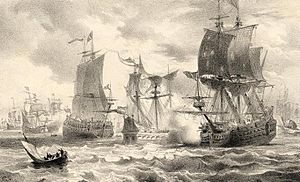Battle of Cape St. Vincent (1641) facts for kids
Quick facts for kids Battle of Cape St. Vincent |
|||||||
|---|---|---|---|---|---|---|---|
| Part of the Eighty Years' War | |||||||
 Battle of Cape St. Vincent, by Carel Christiaan Antony Last |
|||||||
|
|||||||
| Belligerents | |||||||
| Commanders and leaders | |||||||
| Strength | |||||||
| 20 warships | 23 warships | ||||||
| Casualties and losses | |||||||
| 100-200 killed or wounded, 2 ships sunk | 1,100 killed or wounded, 2 ships sunk | ||||||
The Battle of Cape St. Vincent of 1641 was a naval battle that happened on November 4, 1641. It took place near Cape St. Vincent in Portugal. A Spanish fleet, led by Don Juan Alonso de Idiáquez y Robles, met a Dutch fleet, led by Artus Gijsels. This battle was part of the long Eighty Years' War between Spain and the Dutch Republic.
After a tough fight, two Dutch ships were sunk. The Dutch reported about 100 to 200 of their men were killed or hurt. The Spanish fleet also lost two ships, but they had many more casualties, over 1,000 dead or wounded. The Dutch fleet was damaged and had to give up its plan to attack the important Spanish treasure fleet. The battle ended without a clear winner for either side.
Why the Battle Happened
In 1641, a new war started called the Portuguese Restoration War. Portugal wanted to be independent from Spain. The Portuguese government decided to attack Spain by sea. They got help from the Dutch and the French.
A Portuguese fleet of 16 ships joined 30 Dutch ships. The Dutch fleet was led by Artus Gijsels. Their goal was to capture the Spanish towns of Cádiz and Sanlúcar. However, their plan didn't work out. They met five ships from Dunkirk (a port city) near Cape St. Vincent. These ships were chasing pirates from Algeria. The Dunkirk ships managed to warn the Spanish in Cádiz.
Because of this, the Portuguese and Dutch fleets went back to Lisbon. The Portuguese commander was replaced. Then, the Dutch fleet sailed off on its own. Their new mission was to find and capture the Spanish West Indies Fleet. This fleet carried valuable goods from the Americas. The Dutch had to act fast because their ships were ordered to return home if the treasure fleet didn't appear before November.
The Battle Begins
Spain quickly gathered its ships to stop the Dutch fleet. Ships from Galicia and Naples, along with other large warships called galleons, met in Cádiz. Don Juan Alonso de Idiáquez y Robles, the Duke of Ciudad Real, was put in charge of the Spanish fleet. He was a skilled soldier on land but didn't have much experience in sea battles.
On November 4, the Dutch fleet, led by Gijsels, was seen near Cape St. Vincent. The Duke of Ciudad Real immediately ordered his ships to attack the main Dutch vessels. The fighting was intense. The Spanish suffered many losses. Eventually, the Duke stopped the attack and ordered his ships to retreat to Cádiz.
King Philip IV was not happy with this outcome. He strongly criticized several officers, including the Duke of Ciudad Real. A famous Dutch admiral, Michiel de Ruyter, was also part of this battle as a Rear Admiral in the Dutch fleet.
What Happened After
After the battle, some of the Dutch ships were badly damaged. Their Portuguese and French allies had left them. These Dutch ships had to sail to England to get repairs. The battle showed that neither side could easily defeat the other at sea.
See also
 In Spanish: Batalla del Cabo de San Vicente (1641) para niños
In Spanish: Batalla del Cabo de San Vicente (1641) para niños

